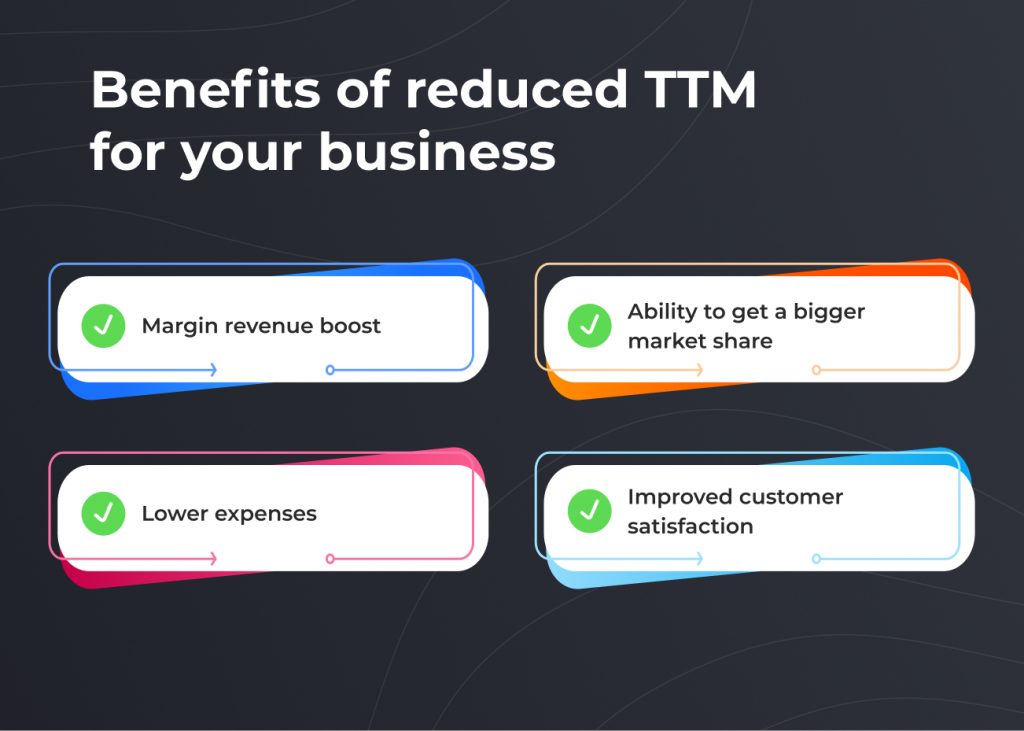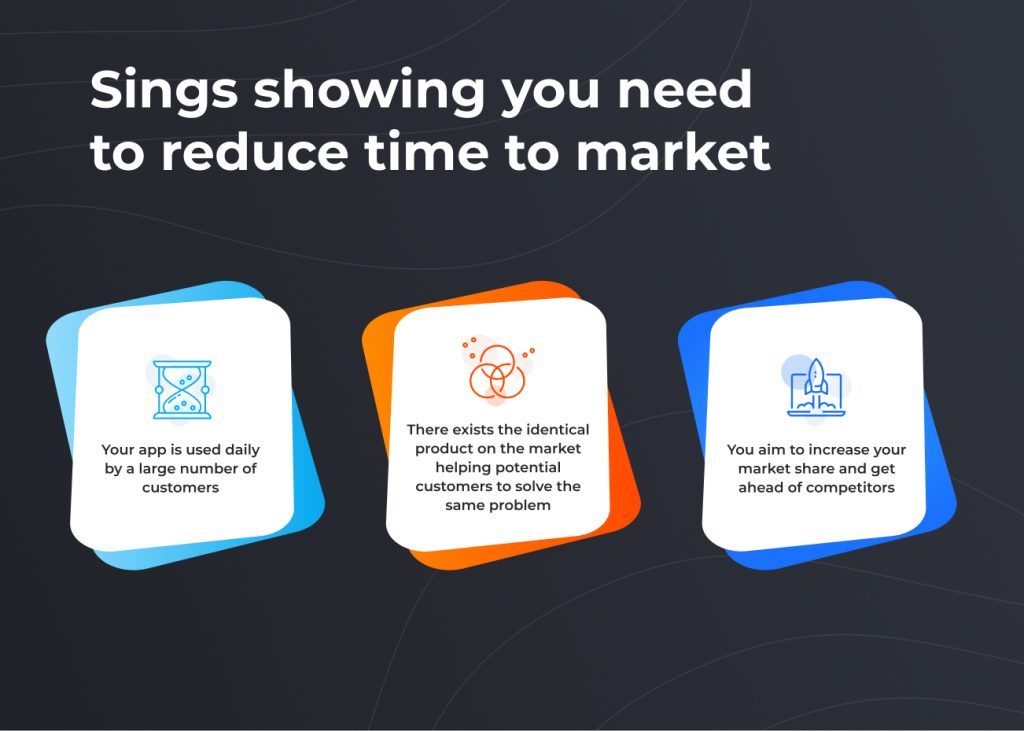Surviving this market battlefield is one of the main aims of modern business approaches. Today companies are spending huge sums of money on product development overlooking such an important aspect as speed. Time to market or TTM is one of the most important business metrics you should orient on, in case you want to get ahead of the competition and occupy the leading positions in your business niche.
What is the time to market process and why is it important?
Business digitalization has allowed companies to roll out more launches, pilot and scale new services faster exploring new market opportunities. Speed is a considerable benefit guaranteeing you better brand recognition and a high level of customer loyalty before competitors entered the market with the same products.
Time to market or TTM is the time needed to develop a product and prepare it for launch. During this period, the idea is shaped, designed, tested, the product is built, and presented to the target audience.
Main types of Time to Market
Here are the major types of time to market.
- Speedy time to market – it is the type of TTM, when the main company’s goal is the delivery of the product at the highest possible speed.
- Predictable schedules time to market – the product is scheduled to meet the client’s needs at a specific time, so the major releases are based on these schedules.
- Flexible time to market – the time to market will change depending on the needs of the customers. The main metric here is client satisfaction.
- Minimized time to market – here the main aim is to cut the expenses on the team, without taking into account the needs of the customer, market trends, and endeavors of the competitors.
Why is it important to cut your time to market?
Reduction of TTM is very important for the competitiveness of any company. In case the TTM is slow, the product development time passes by and the relevance of the existing products melts away since the needs of the customers are changing. Competitors’ pressure, the rapid development of technologies, and the dynamic market are the key drivers that make companies speed up their time to market.
Here are some reasons why reduce time to market is important:
- Customers expect high-quality service to duct being delivered quickly, having really high expectations;
- You must deliver the value to your customers quicker than the rest of your competitors;
- Delayed delivery results in the loss of the core product feature value;
- Most of the technology unicorns exhibit a desire and ability to continuously improve and deliver products faster than anyone else;
- Time to market provides the ability to measure success. The quicker you deliver the feature, the faster you gather the customer feedback and the better business decisions you make;
- Regular releases decrease the potential risks of failure and allow protecting brand reputation better and allowing to reduce R&D costs.
Competetive advantage and Benefits of reduced TTM for your business
According to the research done by McKinsey & Company – if you are late to market by six months, for the following 5 years your incomes are 33% less than a “right on time” scenario. Moreover, if your time to market is right on the spot, however, you spend 50% more on the product than others, your revenue will only be affected by a 4% loss.
If your time to market is slow, your counterparts will use it and will dominate the market releasing their products much faster. Thus, reduce time to market and your business will benefit you the next way:
- Margin revenue boost. The quicker you enter the market the more revenue you will generate.
- Lower expenses. The earlier you release the product the lower the expenses since it takes less time to present the product to the market and you will need to produce fewer cases.
- Ability to get a bigger market share. If you offer a solution that has no analogs on the market, users will appreciate it.
- Improved customer satisfaction. You will be able to satisfy the customers’ insatiable desire for the newest features and better experience.

How to measure time to market and what are typical measurements
Measurement is a central step to improvement. You can not know whether you need to increase your product development productivity and consequently cut your TTM until you measure it. The first measurements of the time to market simply captured the overall time it took to release the product.
Usually, the product development time to market KPI is the period from when a team starts to the first customer delivery. The new measures are capturing time by phase, time by milestone, and finally overall time.
The measurement of the time to market depends on the type of your product. It may take days, months, and even years. Further, we will dwell upon the most efficient ways to measure TTM and will analyze the typical measurements.
- You may start tracking the time to market since the idea is shaped.
- You may stop tracking after the first version of the product is released.
- You may start tracking the time to market after the budgeting is approved, however as it is often the case the team already starts working before the budgeting is confirmed. For instance, they may create the initial product design.
- You may start measuring the time to market when the team is already available, and you have the initial sedition of the product, thus the risks are minimal.

The bright real example of time to market measurement strategy was presented by Hewlett-Packard enterprise. They have elaborated a special “Return Map” that allows them to track project and product lifecycle.
This visualization tool reflects the whole product development process, demonstrating how the workflow elements affect the KPI success and the overall time and money effort. It allows us to track and see the effect of product development tempo on profits realization.
However, you need to understand that these measurements will never be 100% exact since many factors influence the development process including the organization of the team, the innovation needed to differentiate the product from the competition, and the overall scope of the product. These are the external factors you may have a little effect on, however, you may speed up the delivery process and cut the product release cycles. Let us dwell upon it further.
What slows down your time to market
Apart from the factors you cannot influence, there are some aspects you can take under control. Here we are going to go through the main software development aspects that may slow down your TTM.
- Communication. Insufficient communication can create a real mess in your project. According to the research, if the average US $135 million is at risk in projects, more than half of that is due to poor communication.
- Code quality. Code quality plays a crucial role in the software development process. Tech debt, poor app performance, and many other unaddressed accumulated performance issues may cause considerable delays.
- Outdated practices. Outdated practices as a rule lead to higher legacy levels. The lack of DevOps specialists in the team and lack of automation in software development processes may result in huge tech depts and increased tech dept spending instead of allocation of the budget for more strategic moves.
How can you use the time to market strategically
Time to market is an aspect, that is often overlooked by business owners. However, it can be used as an effective strategic move, that will provide you with a considerable competetive advantage.
Sings showing you need to reduce time to market
- your app is used daily by a large number of customers
- there exists the identical product on the market helping potential customers to solve the same problems
- you aim to increase your market share and get ahead of competitors

If these signs are relevant to yout daily business aims, it means you can considerably reduce your time to market and use it as a great strategic point.
How to reduce time to market:
- Use Agile development methodologies. Speed up the development process through the optimization of the workflow.
- Adjust the infrastructure. The main functions you need to fulfill is future scalability and consistency. Grow software together with your business growth and ensure the needed level of automation.
- Intensify the resource commitment and overcome limited team capabilities. A lack of knowledge and expertise necessary to may be a barrier standing between you and a new robust product.
In such a case, you should sketch out a development plan and reorganize the team make-up to best reflect the current needs. This may include outsourcing your software development or hiring an extended team of specialist
- Reduce the scope of the project or release an minimum viable product. It enables the team to move very quickly, reading the product with the core features only.
How to improve your time to market with Agile?
Cultivating the Agile methodology in software development creates a solid ground for improvement of your company’s TTM.
Scrum methodology allows you to focus on the current priority tasks without losing your resources on a variety of different tasks.
Instead of that, a scrum master optimized the workflow of the team, being responsible for the prioritization of tasks and monitoring whether they are finished by the team in time.
If the team works with scrum methodology, they do not need detailed documentation on the whole development processes. They just perform the priority tasks. The best way possible, thus considerably reducing the overall time to market indicators.
If you are a startup working on the launch of a new idea, it is better to focus on the Lean startup methodology. Real-time communication with customers, regular testing of the ideas, and the launch of minimum viable product allow you to considerably improve the TTM and avoid the implementation of unnecessary features.
Tips on how to introduce more agility into daily software operations:
- Use the fast-fail methodologies like Scrum or Agile;
- Exchange regular customer feedback after introducing new features;
- Make a record of all software issues to solve;
- Foster communication across various teams;
- Use workshops to gather product intel.
Product development process that can reduce time to market
Streamlining the delivery process can help to considerably reduce time to market and cut the release timelines.
- Product launch may demand several levels of improvement. It is necessary to thoroughly go through the main strategic points, before investing large sums of money. However, working on the project management strategy, one’s tidying up all the steps, possible pain points, and delays may save you some weeks for the approval process and thus reduce time to market.
- Outsourcing to an extended team. For sure, you will need considerable tech support from the outsourcing partner. Make sure to develop a trusted network of contractors having extended experience in your industry, who will be likely to meet your project requirements with reduced timelines.
- In the process of product development, it is very likely that bottlenecks may occur when product development is moved from one department to another. The creation of a clear integration system and making enough investment to improve those systems may provide you with a considerable speed advantage
- Handling repetitive tasks with the implementation of the latest technologies will also reduce time to market. Automated systems, synchronized calendars, real-time reflection of changes, and advantages report spreadsheets are other strategic points, you should consider while looking for efficient ways to reduce the release timelines.
- Strategy is your everything. You need to be flexible enough and continuously adjust to changes throughout the whole development process. It will enable you to stay relevant in a competitive industry, no matter what.
- Develop pilot-ready customer segments, when you can introduce your product with an acceptable risk level. These target audiences may become co-innovators of your product and also increase the TTM.
- Efficient tracking of the results will help inter-team collaboration and boost efficiency. Collecting and sharing information in real-time will increase the overall process visibility, and ensure all the main objectives will be met with the needed speed and degree of transparency.
Thus, following the above-mentioned strategy can help to enter the market faster with increased efficiency and maintain the hush level of software.
Reducing time to market with an extended team
The extended team model brings together the customer’s in-house developers and remote specialists from an IT outsourcing company. You can either hire a CTO or PM to manage a team or manage it personally.
Developers from the extended team will use their skills to complete the in-house project manager’s tasks, possessing the needed specific expertise, and being able to adjust to your personal business needs. Since all project management activities happen on the client’s side, you have full control over the project.
Here are some benefits of choosing the extended team model:
- Fosters mutual contact between the team members;
- The development process becomes more cost-efficient and quick;
- The needed talents are always available;
- The project meets all deadlines, thus considerably reduce time to market;
How we do it at Altamira
Altamira team can help you to significantly reduce time to market by providing a full spectrum of team augumenntation services, including outsourced team and dedicated team models.
In case you are looking for a cost efficiency and expertise – this option will be perfect for you.
As our customer, your will be provided with a RACI matrix, containing all project documentation, roles and responsibilities defined, as well as a clear communication plan. It will provide you with a full picture and better understanding of processes and responsbilities.
You can read more about team extension in our related blog article.
Our company offers the best price-quality ratio, guranteeing great expertize, reasonable rates, tight deadlines and high quality service.
Based on the latest NPS results, our clients choose us, since we offer scalability, efficiency, reasonable pricing, flexibility and fast time to market allowing you to considerably reduce your TTM.
Sometimes your in-house team may nnot be able to cope with all the tasks faced, reducing your productivity and allowing the counterparts to get ahead on the market. Hiring the new team members, you may attract to your project people with the specific skills, knowledge and expertise and accopmlish complex software development process, considerably reducing the time to market.
Just select a team of specialists, sign a contract and successfully integrate new experts into your team to do their best to move your business to a new level!
Possible risks you need to consider
For sure, there are several risks you need to take into account to not lose focus during the software development process. Speed is great, however, you need to move forward wisely, without getting absolutely swallowed by the time to market.
In case all your efforts are aimed at rolling out the product on a specific date – you may fall short on market expectations and entirely lose focus.
Constant adjustment and concessions may play a bad trick on you. Thus you need to always remember that the goal is not being first – you need to enter the market at the right time with the highly demanded product that will satisfy the current consumer demand.
To sum up
Time to market is one of the most important business KPIs. The shorter it is, the quicker return on investment you will get.
As you may have already guessed, it mostly depends on the efficiency and choosing an efficient internal project management strategy.
Short time to market enables the rapid introduction of new technology, offering companies a considerable competitive advantage.
Reduce time to market allows for a short development time, increasing the relevance of your product for the current niche, and increasing the customer satisfaction rates.






